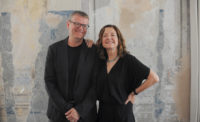In September, Mark Wigley, dean of Columbia University’s Graduate School of Architecture, Planning and Preservation (GSAPP), announced that he would step down from his position at the end of the academic year, in June 2014. Wigley, who has a B.Arch. (1979) and a Ph.D. (1987) from the University of Auckland in New Zealand, assumed the deanship in 2004. Since coming to the United States in the late 1980s, Wigley has produced a series of provocative books and exhibitions on architecture, besides teaching at Princeton University and Columbia. The news of Wigley's departure from Columbia came on the eve of a conference that he had helped organize, “The Future of Energy,” which was held October 2 at the Museum of Modern Art in New York. Record took the opportunity to ask Wigley about his thinking behind this initiative as well as other aspects of his legacy.
 |
| Photo via The Audi Urban Future Initiative Mark Wigley |
How does GSAPP’s recent conference on energy fit into your pedagogical strategy?
Schools usually cultivate students working as soloists, but architectural practice doesn’t work that way. In the past few years GSAPP has been organizing the Columbia Building Intelligence Project (CBIP) where 30 students come together to collaborate in real time on a single project, sharing the same software platform. In terms of our recent conference, collaboration is the medium and energy is the message. We believe that the future of architecture is in energy, but not energy as currently understood. Energy itself is a question.
But don’t we all think that sustainability is part of architecture’s future?
What we mean is that we need whole new concepts about the relationship between architecture and energy–it’s not just about the mechanics of saving energy. Sustainability is looked on obviously as good, but I’m suspicious about anything thing that is obviously good. Any sense of virtue gets in the way of serious work. So most of the huge amount of work done in the area is not that interesting. We thought Columbia should be more innovative about the concept of energy itself before committing to particular applications. We wanted to be ambitious about transforming this relationship to create new paradigms, building them collectively and sharing. Our mandate is to ask radical questions for radical answers.
You have enlisted a building products manufacturer, Oldcastle BuildingEnvelope, for your energy project. How did that happen?
Oldcastle BuildingEnvelope and chief executive Ted Hathaway partnered with us from the very beginning of this project. They also feel the future of architecture is in energy. So they worked collaboratively with GSAPP to create this new platform—to help wake people up. The term “energy” needs to be used more provocatively. This was underscored by our keynote speakers Jeffrey Sachs, the influential economist who is head of the Earth Institute at Columbia, thinking at the scale of the planet, and Matthias Schuler, CEO of Transsolar KlimaEngineeering in Stuttgart, which has been experimenting with energy solutions at the scale of buildings. He is a philosopher of energy.
Is it unusual for corporations to get involved in academic conferences?
The most interesting corporations have started to think about the same things as young architects. Oldcastle became a natural research partner with CBIP a few years ago. We started working with them when we were investigating the relationship between architecture, engineering [with Columbia’s Department of Civil Engineering and Engineering Mechanics], and materials. While Oldcastle was involved in our conference on glass (2007), LaFarge got involved with the conference on concrete (2008); the Steel Institute of New York backed our conference on metals (2009), and the Vinyl Institute sponsored the one on plastics (2011). All these materials have gone through high-performance revolutions in the last 10 years. There is nothing basic about the basics anymore.
And how does architectural education benefit from this alliance with corporations?
We see the university as an experimental lab. In the past that implied a distance from practice. Experiments were always more radical than what was happening in the field. But today professionals have to have an experimental capacity to keep pace with the astonishing speed of change in cities. Cities have become more experimental than universities. So there is a new synergy between research in the field and research in the university.
What about the university’s identity as a scholarly place of learning and thinking within the halls of ivy—where you can remove yourself from the world to examine its problems?
GSAPP is defined by its interest in what might come next. That doesn’t mean you don’t look at history. On the contrary, you really need to understand the past. You can only jump from a solid base. That’s why GSAPP is built around the great Avery library. The future is not simply invented—it’s a project, it’s designed and constructed. The world’s population will be at least nine billion in 2050, and seven billion will be living in cities, so we can’t be inching toward the future: there has to be a leap. We owe it to our grandchildren. We urgently require a different paradigm. And real knowledge is not strong and stable with everything figured out. The knowledge that counts is always in formation. There is not just one doctor nor one kind of medicine: we need a collaborative methodology. The architectural field will only be relevant according to the extent that it shares. We have to go open source.
GSAPP has also introduced global studios under your leadership. These are different from university branches in far-flung places. How did you come to this decision?
If we want to help take care of cities, we need a new architecture of sharing which for us takes the form of a network of interlinked research studios in the historic hearts of key cities around the world. So we started the Studio-X Global Network in New York, Beijing, Mumbai, Rio, Johannesburg and our sixth, Studio-X Istanbul, opens in November. Smaller labs are active in Amman, Sao Paulo, and Tokyo. Universities need to evolve, even to turn themselves inside out: we cannot be disconnected from the world. We have to take our precious labs and place them in the middle of the world. Each Studio-X is like an artist's studio having a permanent open house. They are spaces of production, reflection, and communication. During the day teams conduct research, and in the evenings they debate, hear lectures, and attend performances.
We can’t stay within our own campus walls. And how could you have an architecture school be only in one place? To invent and protect ideas, you need to share. Sharing is the real engine of innovation. Brilliant new thoughts come through the strange collision of people and cultures. Cities themselves incubate imagination. This is a new phase in the evolution of the university. It is opposite of branch campuses–which usually become a neo-colonial occupation across the globe. For example, we want to learn in and with Rio. We are not there to teach Rio. The Studio-X network is not an exotic extension or outpost of the classical university. It is the very heart of the university, the core space of learning through sharing.
With all this going on, why you are stepping down as dean?
I always said I would do this unbelievable project of guiding the school for 10 years. It is addictive and tempting to keep going. But I would like to start new projects with new thoughts. And I think experimental schools should also experiment with new deans.
What do you think of doing first?
First I will take a sabbatical and return to writing. Being a scholar again is as exciting to me now as being a dean was a decade ago. We have amazing students and faculty, who are super dynamic and engaged. The university is like a garden. I was just building a new kind of pergola. Amazing plants appeared and flourished, an ecology of imagination with its own momentum. I don’t want to control that. New plants will grow. Each will flower in its own way.






Post a comment to this article
Report Abusive Comment